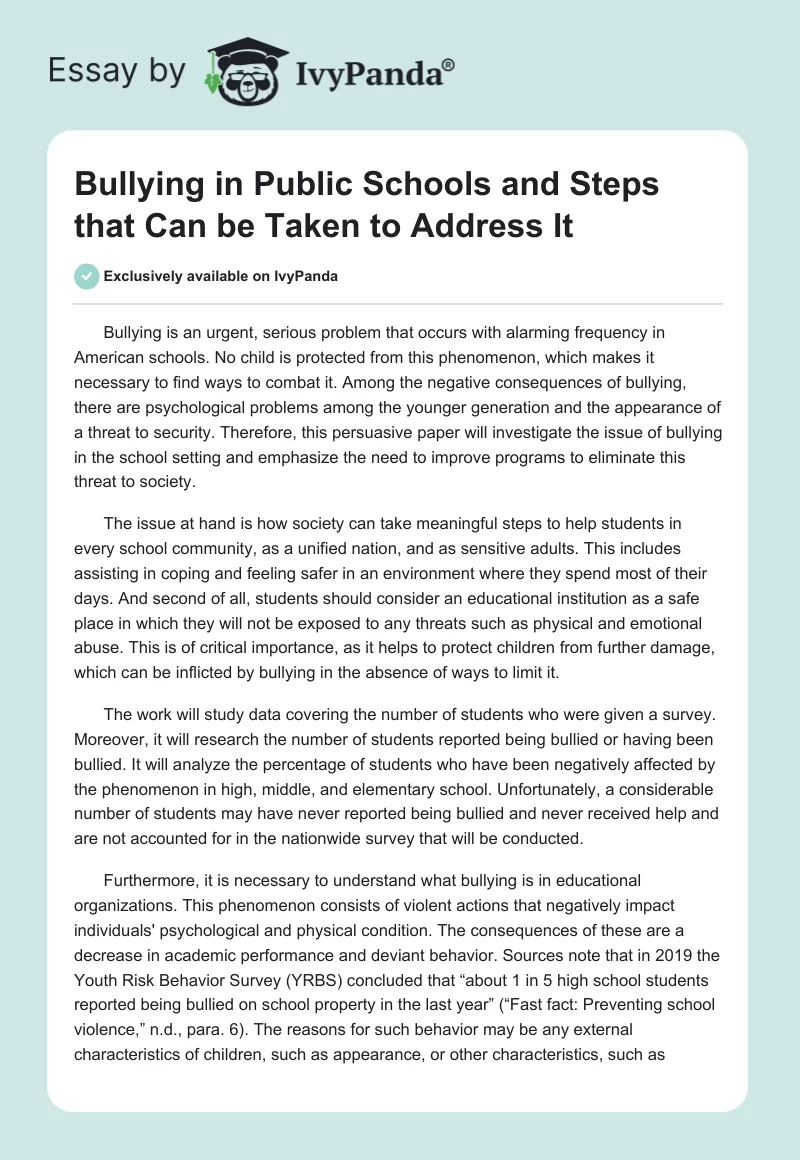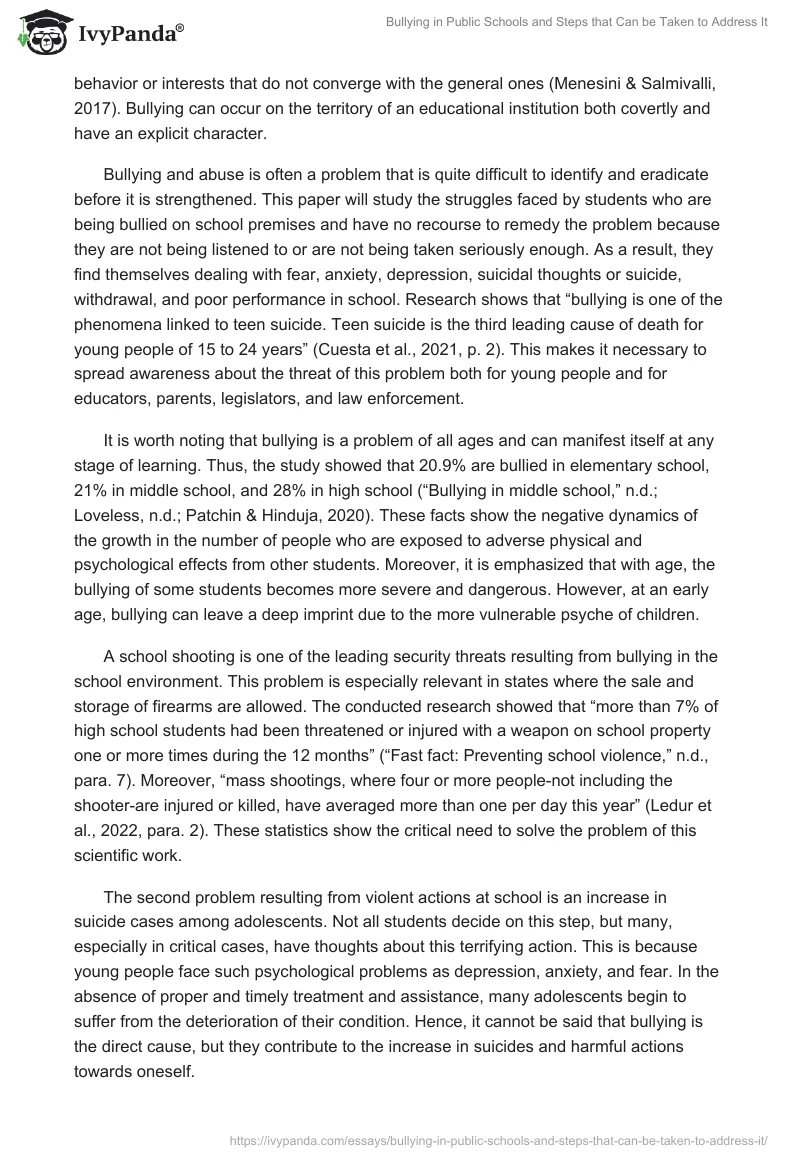Bullying is an urgent, serious problem that occurs with alarming frequency in American schools. No child is protected from this phenomenon, which makes it necessary to find ways to combat it. Among the negative consequences of bullying, there are psychological problems among the younger generation and the appearance of a threat to security. Therefore, this persuasive paper will investigate the issue of bullying in the school setting and emphasize the need to improve programs to eliminate this threat to society.
The issue at hand is how society can take meaningful steps to help students in every school community, as a unified nation, and as sensitive adults. This includes assisting in coping and feeling safer in an environment where they spend most of their days. And second of all, students should consider an educational institution as a safe place in which they will not be exposed to any threats such as physical and emotional abuse. This is of critical importance, as it helps to protect children from further damage, which can be inflicted by bullying in the absence of ways to limit it.
The work will study data covering the number of students who were given a survey. Moreover, it will research the number of students reported being bullied or having been bullied. It will analyze the percentage of students who have been negatively affected by the phenomenon in high, middle, and elementary school. Unfortunately, a considerable number of students may have never reported being bullied and never received help and are not accounted for in the nationwide survey that will be conducted.
Furthermore, it is necessary to understand what bullying is in educational organizations. This phenomenon consists of violent actions that negatively impact individuals’ psychological and physical condition. The consequences of these are a decrease in academic performance and deviant behavior. Sources note that in 2019 the Youth Risk Behavior Survey (YRBS) concluded that “about 1 in 5 high school students reported being bullied on school property in the last year” (“Fast fact: Preventing school violence,” n.d., para. 6). The reasons for such behavior may be any external characteristics of children, such as appearance, or other characteristics, such as behavior or interests that do not converge with the general ones (Menesini & Salmivalli, 2017). Bullying can occur on the territory of an educational institution both covertly and have an explicit character.
Bullying and abuse is often a problem that is quite difficult to identify and eradicate before it is strengthened. This paper will study the struggles faced by students who are being bullied on school premises and have no recourse to remedy the problem because they are not being listened to or are not being taken seriously enough. As a result, they find themselves dealing with fear, anxiety, depression, suicidal thoughts or suicide, withdrawal, and poor performance in school. Research shows that “bullying is one of the phenomena linked to teen suicide. Teen suicide is the third leading cause of death for young people of 15 to 24 years” (Cuesta et al., 2021, p. 2). This makes it necessary to spread awareness about the threat of this problem both for young people and for educators, parents, legislators, and law enforcement.
It is worth noting that bullying is a problem of all ages and can manifest itself at any stage of learning. Thus, the study showed that 20.9% are bullied in elementary school, 21% in middle school, and 28% in high school (“Bullying in middle school,” n.d.; Loveless, n.d.; Patchin & Hinduja, 2020). These facts show the negative dynamics of the growth in the number of people who are exposed to adverse physical and psychological effects from other students. Moreover, it is emphasized that with age, the bullying of some students becomes more severe and dangerous. However, at an early age, bullying can leave a deep imprint due to the more vulnerable psyche of children.
A school shooting is one of the leading security threats resulting from bullying in the school environment. This problem is especially relevant in states where the sale and storage of firearms are allowed. The conducted research showed that “more than 7% of high school students had been threatened or injured with a weapon on school property one or more times during the 12 months” (“Fast fact: Preventing school violence,” n.d., para. 7). Moreover, “mass shootings, where four or more people-not including the shooter-are injured or killed, have averaged more than one per day this year” (Ledur et al., 2022, para. 2). These statistics show the critical need to solve the problem of this scientific work.
The second problem resulting from violent actions at school is an increase in suicide cases among adolescents. Not all students decide on this step, but many, especially in critical cases, have thoughts about this terrifying action. This is because young people face such psychological problems as depression, anxiety, and fear. In the absence of proper and timely treatment and assistance, many adolescents begin to suffer from the deterioration of their condition. Hence, it cannot be said that bullying is the direct cause, but they contribute to the increase in suicides and harmful actions towards oneself.
Introducing measures to eliminate bullying in schools should reduce the amount of stress and aggression in educational institutions. Hence, on the part of educators and school leaders, it is necessary to conduct training to spread awareness about the harm and negative consequences of bullying (U.S. Department of Education, 2022). It is important to introduce measures to unite students, establish friendly relations and create a positive environment (“Bullying and cyberbullying,” n.d.). This implies the introduction into the educational curriculum of such steps as teamwork, allowing students to get to know each other better and accept each other’s individual characteristics.
Legislative and law enforcement agencies should pay particular attention to this problem. Even though some measures are already being applied, they are not enough since the problem of bullying is still very relevant for schools in the United States of America. In addition to following and complying with their direct duties, law enforcers must take part in education about the danger of bullying and provide prevention information and resources. Hence, they can participate in events organized by schools and particular organizations and provide data and statistics about the problem. Moreover, it is possible to develop new programs and legislative projects that will restrict minors’ access to weapons. In addition, it is necessary to disseminate information about hotlines and organizations that can help teenagers in difficult situations and provide support and assistance.
In conclusion, the main task of this persuasive paper was to prove the need to solve the problem of bullying in an educational environment. This problem is of particular relevance and poses a threat to society, especially to students. The main issue is that in addition to psychological and physical violence, bullying at school can provoke such security threats as school shootings and suicide among teenagers. Therefore, educators and law enforcers should jointly take measures to help create a positive and danger-free environment for children.
References
Bullying and cyberbullying. (n.d.). School Savety.gov. Web.
Bullying in middle school. (n.d.). BRIM. Web.
Cuesta, I., Montesó‐Curto, P., Metzler Sawin, E., Jiménez‐Herrera, M., Puig‐Llobet, M., Seabra, P., & Toussaint, L. (2021). Risk factors for teen suicide and bullying: An international integrative review. International Journal of Nursing Practice, 27(3). Web.
Fast fact: Preventing school violence. (n.d.). Center for Disease Control and Prevention. Web.
Ledur, J., Rabinowitz, K., & Galocha, A. (2022). There have been over 300 mass shootings so far in 2022. The Washington Post. Web.
Loveless, B. (n.d.). Bullying epidemic: Facts, statistics and prevention. Education Corner. Web.
Menesini, E., & Salmivalli, C. (2017). Bullying in schools: the state of knowledge and effective interventions. Psychology, Health & Medicine, 22(1), 240-253. Web.
Patchin, J.W., & Hinduja, S. (2020). Tween cyberbullying in 2020. Cyberbullying Research Center and Cartoon Network. Web.
U.S. Department of Education. (2022). Report on indicators of school crime and safety: 2021. Institute of Educational Sciences. Web.


